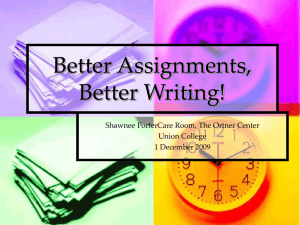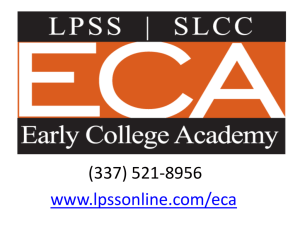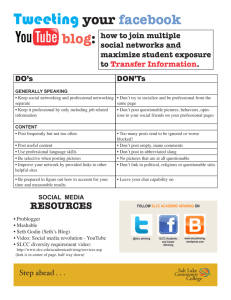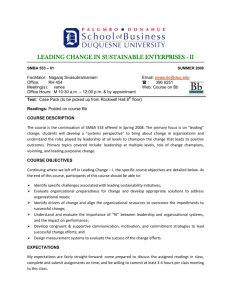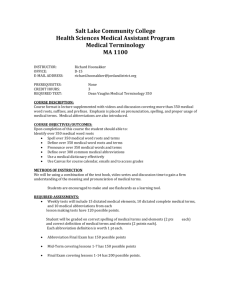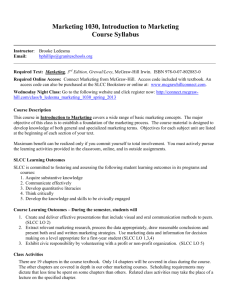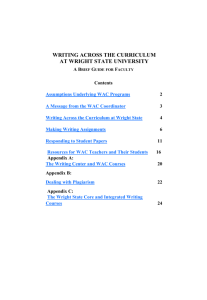Bill of “Writes” and Responsibilities for Students
advertisement
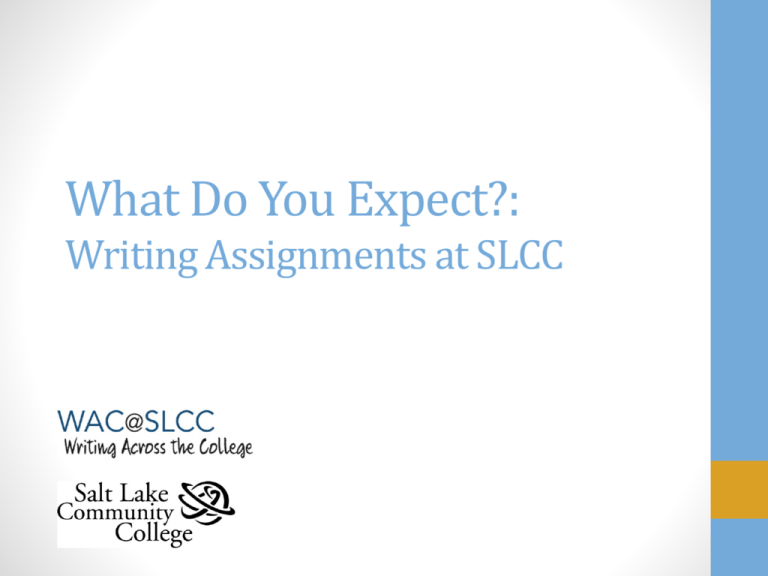
What Do You Expect?: Writing Assignments at SLCC X X Center for Innovation, Professional Dev. Manager X X Communication and Performing Arts, Assoc. Dean X English (transfer-level), Faculty X X English (developmental), Faculty X X Faculty Services, Director X First Year Experience, Director X Health Professions, Faculty X Science, Math, and Engineering, Writing Coordinator X X X X X X X Student Life and Leadership, Student Rep. X X X X Student Life and Leadership, Assoc. Director Student Writing Center, Lead Tutor X X X Library Services, Director Admin X • Asymmetrical Expectations • Emotion • Mechanics Aviation and Related Technologies, Admin. Asst. Faculty Staff Student Institutional Effectiveness X Student Services Accounting, Finance, and Economics, Assoc. Dean Career and Technical Ed. Position at SLCC Academic The Problem X X X X Typical Responses 1. “Students should be better prepared!” “What are those English teachers/high school teachers teaching?!?” 2. Only nine (9) non-English department courses at SLCC have English 1010 as a Writing Across Curriculum: “Everyone courses shouldatbethe college. prerequisite. That’sthe fewer than 1% of credit-bearing teaching writing!” The Student Writing Center provides anecdotal evidence of working with •“Teachers WAC can in improve all disciplines subject should specific adopt comprehension writing as part and of writing, their pedagogy but only students who are enrolled in Writing 0990 (or 0900) and 2000-level courses both when to improve it is consistently student writing and rigorously and optimize applied. learning in the discipline.”— at the same time. Many of these students struggle to understand what ”WAC Can Work” writing assignments are even asking of them. • WAC practitioners require extensive pedagogical training, and then experience an average 25% increased workload when implementing WAC into their courses. We Are Not Alone… In a study that examined 2,101 writing assignments of all kinds (short answer, reflection, research) across all types of higher education institutions, Dan Melzer found the following: 1. The purposes and audiences of the assignments were limited: more than 60% were “to inform” and “the teacher.” 2. However, the genres genres were quite varied (e.g. lab reports, abstracts, literature reviews, business memos, book reviews, and annotated bibliographies) and… 3. Instructors’ expectations for similar genres differed widely from course to course and discipline to discipline, so much so that… 4. Each course could be considered its own discourse community. What to do? Start with something small, consistent, and sustainable…. Reduce Asymmetrical Expectations • Create an SLCC Bill of “Writes” and Responsibilities for Students and Faculty consisting of the fundamental expectations for each role in regards to writing assignments. • Develop in collaboration with faculty divisions and student leadership. • Seek endorsement from Faculty Senate and Student Senate. • Infuse document into Student Handbook, first Year Experience, Faculty Development, Adjunct Support *To see all WAC@SLCC priorities for 2015-2016, visit www.slcc.edu/wac Sample Ideas • Students have a right to be provided with an accessible document that describes the writing assignment (beyond a statement on a syllabus) to which they can return. Faculty have a responsibility to provide to students an • Faculty have a right tothat expect that students have read the accessible document explains the assignment’s writing assignment and have made every effort to understand purpose, audience, and evaluative criteria. what it is asking them to do. Students have an obligation to fully read writing assignments • Students have a right to ask questions about the writing in detail before asking questions of their faculty. assignment and have them answered. Faculty have a responsibility to respond to questions regarding • Faculty have a right to have different writing expectations writing assignments the within best oftheir theirdepartment ability. than other faculty dotoboth and outsider of it. Students have a responsibility to accept that different people read the same piece of writing differently. Next Steps 1. Meet with divisions and student leadership to share this presentation 2. Solicit suggestions and feedback on proposed elements of the document 3. Analyze and synthesize input to draft document 4. Present to Faculty Senate and Student Senate
